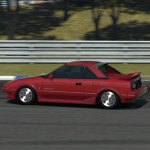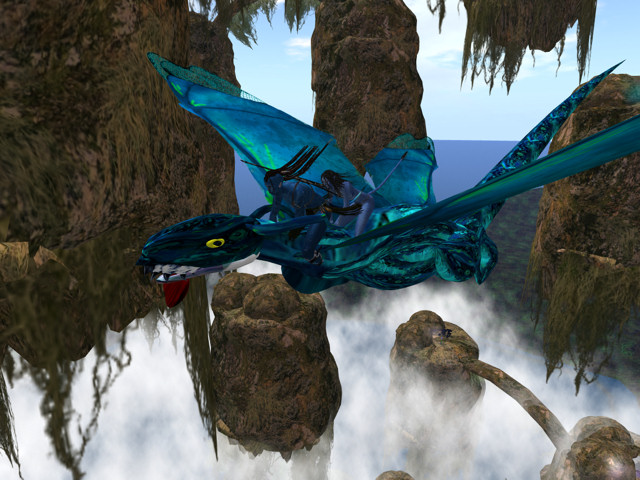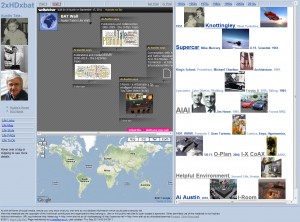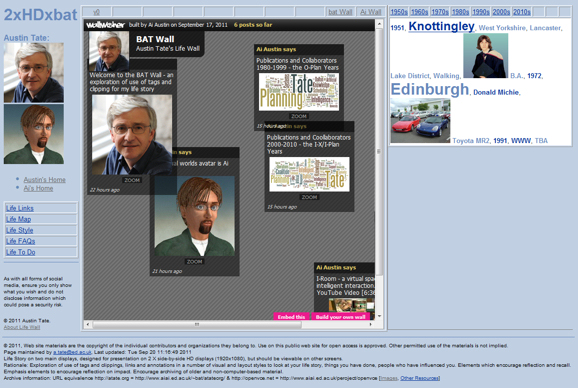Archive for September, 2011
Lifestream Week 2
Posted by Austin Tate in EDC11 on September 29, 2011 Edit
I am finding the summary of logos postings, comments and image uploads that I engage in across a typical work week an interesting observational sport. I did a bit of analysis of the keywords and phrases in my postings across edc11.education (for EDEDC11) and Holyrood Park (for IDEL11) and a Wordle scatter diagram of the phrases used.. and it shows a lot of consistency in the topics I blog about across the two areas. The “Life Wall” which I put quite a bit of energy into in the first two weeks of the MSc in e-Learning figures most prominently.
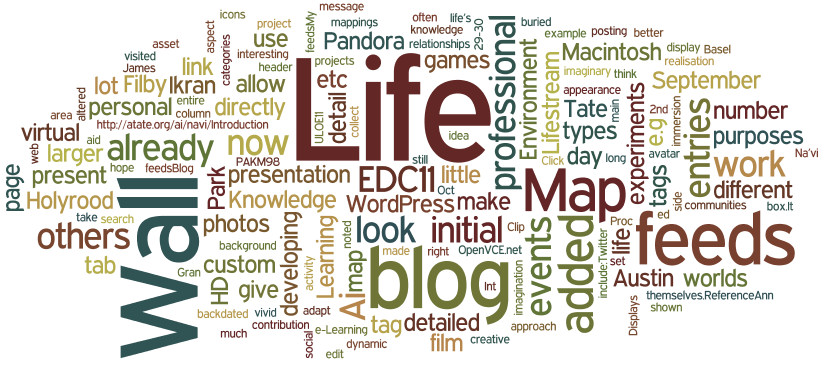
Wordle Diagram for EDC11 as at
28-Sep-2011
My Life Wall at http://atate.org/ is now pretty much as I wanted it to be… though I have yet to work out how to properly add tags onto the Google map.
I had quite a few tweets and some blog entries about “Other Worlds” a theme of the film fest and tweeting events on EDEDC11 this week. I drew attention to some highly detailed world and imaginative worlds developed in film (Avatar), Prose (Larry Niven’s Ringworld), Games (Gran Turismo) and Artworks (Vincent Van Gogh’s “Starry Night” reconstruction in Second Life). It allowed for some enthusiastic exchanges between myself and other class members on these areas. I provided YouTube video links for these in SynchTube at http://www.synchtube.com/r/aiaustin.
Recollections of the first few years of the net
Posted by Austin Tate in EDC11 on September 28, 2011 Edit
While reading Bell (2001) I was reminded of the time in the late 1960s and early 1970s when cyberculture was beginning.. and how quickly it grew after basic computer access and communication became possible. We are social beings. Let me recall a few things as stepping stones:
My own use of computers began in the days before networks were seriously developed. Computers were largely standalone big machines in air cooled facilities. My first programming exercises at a night class at Leeds Polytechnic around 1967 were submitted on coding sheets via punch operators on punched cards and the turn round was one week to the next evening class.
Things improved when I went to the University at Lancaster in 1969… we could
punch our own cards ![]() and then leave them in pigeon holes
to be run overnight on the University’s single ICL 1900 computer. A mistake in
the program due to a simple typo was a no no if you wanted to get a
result. We could program via flip switches in octal code a DEC PDP-8 that
was the size of a large upright fridge freezer. I write some interrupt
routines for a disc driver on a a basic operating system using a limit of 1K
words of memory on that around 1970.
and then leave them in pigeon holes
to be run overnight on the University’s single ICL 1900 computer. A mistake in
the program due to a simple typo was a no no if you wanted to get a
result. We could program via flip switches in octal code a DEC PDP-8 that
was the size of a large upright fridge freezer. I write some interrupt
routines for a disc driver on a a basic operating system using a limit of 1K
words of memory on that around 1970.
But things were changing and interactive access to the same type of computer was coming thanks to a link up between Edinburgh University AI people and Malcolm Atkinson, then the Computer Manager at Lancaster, and since then a long term colleague, co-investigator and recently Director of the National e-Science Centre based in Edinburgh. A precocious 17 year old programmer called John Scott at Lancaster wrote a real time access version of the Edinburgh POP-2 Language for the ICL 1900 and we were away into the cyberworld for real. We learned POP-2 for most of our programming exercises, for data structures, and for a new AI course at Edinburgh around 1970-1971 which I signed onto. These, and the consequent links to Edinburgh researchers interested in planning using computers set the direction for my whole career. With encouragement from Donald Michie and Jim Doran at Edinburgh I did a final year undergraduate project to build my first AI planner – Graph Traverser 4 – and used a “compilation” approach to how plans were composed. I applied it to a range of benchmark tasks that others had tried their planners on. It far outperformed the others. In July 1972 I was able to get a small grant to allow my continued work on this and its writeup to continue after my degree – my very first research grant!
Donald Michie in Edinburgh had offered me a PhD place at Edinburgh and I joined him at the Department of Machine Intelligence and Perception in October 1972. Real time access terminals using POP-2 and the time sharing Multi-POP system were the order of the day. But it was to be an exciting time…
Within a year the DEC-10 that was used by all AI researchers across Britain was installed in Edinburgh and became connected to the ARPANet – it was the 6th or 7th node on that network. Our access terminals could now be used to “Telnet” across to log on to other DEC-10s. I especially used the Stanford machine. There was rudimentary chat, and e-mail was started with the famous “@” character being used to address users on other hosts. Working for the first 2 hours each morning UK time I was often one of the few people on the entire network and had access to 2 DEC-10s for my work. Multi-User Dimensions (MUDs) were experimented with soon after in the machine I used at Stanford… and the rest is history…
Reference
Bell, D (2001) Storying cyberspace 1: material and symbolic stories, chapter 2 of An introduction to cybercultures. Abingdon: Routledge. pp6-29
Other Worlds in Serious Games
Posted by Austin Tate in EDC11 on September 27, 2011 Edit
Simulations of real or imagined worlds have been used for many years to assist in training.
One of my favourite simulated games is the PlayStation Gran Turismo series… our long loved Toyota MR2, now no longer with us, is still available to me to take for a spin in GT5…
- Toyota MR2 X 2
- Toyota MR2 Mk.1 in GT5
- Toyota MR2 Mk.3 in GT5
Other Worlds in Film – Avatar and Pandora
Posted by Austin Tate in EDC11 on September 27, 2011 Edit
The detailed realisation of Pandora, its geography, flora and fauna by James Cameron and his creative team for the film “Avatar” is a good example of the detailed imagination and background hard science that goes into the creation of an imaginary “other world”. For some this detail and level of potential immersion in the film or its associated media and games is very appealing.
Ai’tswayon and his Ikran Ai’tsyal (Na’vi language for Ai fly and Ai wing) – See http://atate.org/ai/navi/
Introduction to Pandora Youtube Clip – http://www.youtube.com/watch?v=GBGDmin_38E
Lifestream Week 1
Posted by Austin Tate in EDC11 on September 23, 2011 Edit
- Twitter feeds
- Blog entry feeds on the Drupal-based OpenVCE.net – the Open Virtual Collaboration Environment – which I use for my technical blogging for much of my research on collaboration, virtual worlds and intelligent systems
- Various MSc in e-Learning blog posting and comment feeds on the Holyrood Park Hub and Holyrood Park Blogs
- WallWisher Wall feeds
Life Wall Pro – and Refinements – and the Baby Pictures
Posted by Austin Tate in EDC11 on September 22, 2011 Edit
The elements of the Life Wall have been encouraging me to dig out all sorts of stuff that was buried away, and recall events and dates (sometimes with the aid of my wife and others) which were already only dimly there. But they have been brought back to vivid life through developing my personal Life Wall. I assume everyone will want photos of them when very young on their Life Wall… there are few events in life as important as being born! The baby photos of me at a few months old and age 1 year are up there now. Did I look cute then?
The live Life Wall is at http://atate.org/ – Hover a mouse over a tag or clipping for more detail. Click on the thumbnails for some larger versions of the images.
Life Map
I had already added a link to a “Life Map” on which I think a lot of life’s experiences could be noted through places visited and dated events. I feel this element of the Life Wall could be so valuable, that I have adjusted the clippings column that will map to one HD screen of presentation to allow for an embedded Life Map directly on the main display. There is a link to a larger map which could then be shown over 2 X HD displays when clicked.
Life Map Pro
The Life Wall idea and presentation could also be adapted to professional purposes, e.g. to collect together and present a researcher’s entire scientific contribution. It could allow then to look at their work and relationships. They could bring in professional contacts and the mappings between people, projects, organisations, tools, etc. Displays could include professional social network and project relationship diagrams (e.g. CMU Catalyst), FOAF, knowledge asset roadmaps (Macintosh, Filby and Tate, 1998), etc. I am developing this aspect now. As for Life Map Personal I hope to make the approach reasonably general and create an empty Life Map web area which others can copy and adapt to use themselves.
Reference
Ann Macintosh, Ian Filby and Austin Tate (1998) “Knowledge Asset Road Maps” Proc. of the 2nd Int. Conf. on Practical Aspects of Knowledge Management (PAKM98) Basel, Switzerland, 29-30 Oct. 1998, (U. Reimer, ed.). Available from http://www.aiai.ed.ac.uk/project/oplan/documents/1998/98-pakm98-roadmaps.pdf
BAT Life Wall – Refining the Idea
Posted by Austin Tate in EDC11 on September 20, 2011 Edit
I have found the development of the “Life Wall” a very interesting experience, and sort of went to town on developing something that potentially could be reused in different contexts and used by others. Here are some notes I am making on its development.
Origins
The Life Wall came about in September 2011 as Austin Tate was exploring social web and community tools for introducing students to one another on the Edinburgh MSc in e-Learning. WallWisher was used to let people post media clippings to show their interests. But other forms of exchange were also useful.
Rationale
Life Wall is an exploration of use of tags and clippings, links and annotations in a number of visual and layout styles to look at your life story, things you have done, people who have influenced you, etc.. Elements are included to encourage reflection and recall. Emphasis elements encourage reflection on the impact on your life of the things you include. The Life Wall encourages archiving of older and non-computer-based material.
Life Wall is designed to be placed on two main displays, designed for presentation on 2 X side-by-side HD displays (1920×1080), but should be viewable on other screens.
As with all forms of social media, ensure you only show what you wish and do not disclose information which could pose a security risk.
Alternative name: Life Story
Life x N
The Life Wall concept could also be used for a couple. Developing the wall with your partner could be a fun (or surprising) experience and let you recall joint memories. Extensions to an entire family “Life x N” are possible.
Life Lines and Life Style
The displays are designed to be flexible and customisable. A CSS style sheet (“Life Style” – life.css) is used to allow for simple changes of font, style and colours of headings, bullets, etc.
- One display panel can include a pin board for media clippings, images, videos, audio files, etc. WallWisher is one possible choice for this panel.
- A second display supports a tag cloud with tags meaningful to you, and with a relative weight in terms of style. A regular style is adopted for each “Life Tag”: tag weight : url link : hover text : visible text
- A left column may show an image of you, and provided suggestive links, which you can customise or remove. Suggestions include:
- Life Links
- Life Map
- Life Style
- Life FAQs
- Life To Do
BAT Life Wall
Posted by Austin Tate in EDC11 on September 19, 2011 Edit
I have been inspired by the WallWisher and ideas for creative media in some of the course guides for the MSc in e-Learning… and have begun to think of ways to explore the use of tags and clippings to let someone tell their life story in unstructured, time line and narrative ways.
I wanted to look at the idea of your life in 2 x HD screens of display space. My trial setup is called 2 x HD x bat (my initial and long time computer login name). Spoken in a spelled out way as “two” “times” “h” “d” “times” “b” “a” “t”.
This might be useful for some of the assignments on the Digital Cultures
course too ![]()
Welcome to my MSc in e-Learning EDC11 Blog
Posted by Austin Tate in General Post on September 19, 2011 Edit
I am pleased to announce the creation of my bog for the MSc in e-Learning at http://edc11.education.ed.ac.uk/austint/
Feeds on my LifeStream are being aggregated from myself and my virtual worlds avatar “Ai Austin”. They initially include Twitter (@batate and @aiaiaustin), WellWisher walls and the OpenVCE.net Virtual Collaboration Environment where I frequently post content.

